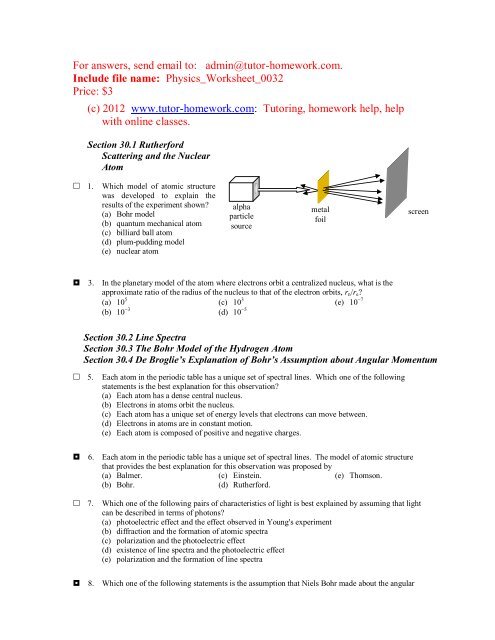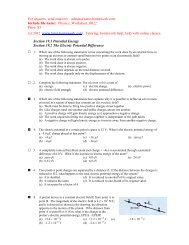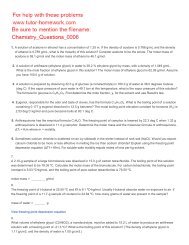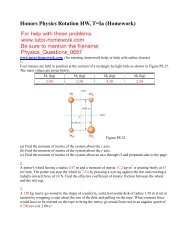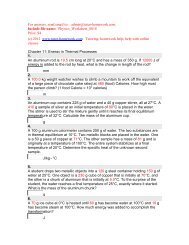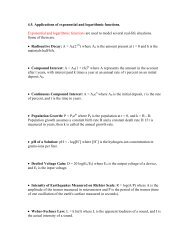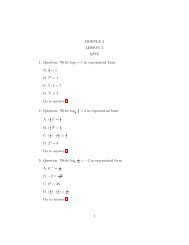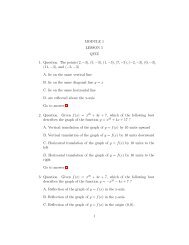Section 1 - Tutor-Homework.com
Section 1 - Tutor-Homework.com
Section 1 - Tutor-Homework.com
- No tags were found...
Create successful ePaper yourself
Turn your PDF publications into a flip-book with our unique Google optimized e-Paper software.
For answers, send email to: admin@tutor-homework.<strong>com</strong>.Include file name: Physics_Worksheet_0032Price: $3(c) 2012 www.tutor-homework.<strong>com</strong>: <strong>Tutor</strong>ing, homework help, helpwith online classes.<strong>Section</strong> 30.1 RutherfordScattering and the NuclearAtom 1.Which model of atomic structurewas developed to explain theresults of the experiment shown?(a) Bohr model(b) quantum mechanical atom(c) billiard ball atom(d) plum-pudding model(e) nuclear atomalphaparticlesourcemetalfoilscreen 3. In the planetary model of the atom where electrons orbit a centralized nucleus, what is theapproximate ratio of the radius of the nucleus to that of the electron orbits, r n /r e ?(a) 10 5 (c) 10 3 (e) 10 7(b) 10 3(d) 10 5<strong>Section</strong> 30.2 Line Spectra<strong>Section</strong> 30.3 The Bohr Model of the Hydrogen Atom<strong>Section</strong> 30.4 De Broglie’s Explanation of Bohr’s Assumption about Angular Momentum 5.Each atom in the periodic table has a unique set of spectral lines. Which one of the followingstatements is the best explanation for this observation?(a) Each atom has a dense central nucleus.(b) Electrons in atoms orbit the nucleus.(c) Each atom has a unique set of energy levels that electrons can move between.(d) Electrons in atoms are in constant motion.(e) Each atom is <strong>com</strong>posed of positive and negative charges. 6. Each atom in the periodic table has a unique set of spectral lines. The model of atomic structurethat provides the best explanation for this observation was proposed by(a) Balmer. (c) Einstein. (e) Thomson.(b) Bohr.(d) Rutherford. 7.Which one of the following pairs of characteristics of light is best explained by assuming that lightcan be described in terms of photons?(a) photoelectric effect and the effect observed in Young's experiment(b) diffraction and the formation of atomic spectra(c) polarization and the photoelectric effect(d) existence of line spectra and the photoelectric effect(e) polarization and the formation of line spectra 8. Which one of the following statements is the assumption that Niels Bohr made about the angular
306 Chapter 30 The Nature of the Atom 35. Which one of the following values of m is not possible for = 2?(a) zero (c) +1 (e) +3(b) –1 (d) +2 36. Two possible states for the hydrogen atom are labeled A and B. The maximum magnetic quantumnumber for state A is +3. For state B, the maximum value is +1. What is the ratio of themagnitudes of the orbital angular momenta, L A /L B , of an electron in these two states?(a) 1.22 (c) 2.00 (e) 3.46(b) 1.73 (d) 2.45<strong>Section</strong> 30.6 The Pauli Exclusion Principle and the Periodic Table of the Elements 37. To which model of atomic structure does the Pauli exclusion principle apply?(a) the nuclear atom(d) the plum-pudding model(b) the quantum mechanical atom(e) the planetary model(c) the billiard ball atom 38. Which one of the following factors best explains why the six electrons of a carbon atom are not allin the 1s state?(a) electron spin(d) Heisenberg uncertainty principle(b) Coulomb's law(e) Rutherford model of atomic structure(c) Pauli exclusion principle 39. Which one of the following statements concerning the electrons specified by the notation 3p 4 is true?(a) The electrons are in the M shell.(b) The electrons are in the = 2 subshell.(c) The electrons are necessarily in an excited state.(d) They have principal quantum number 4.(e) There are 3 electrons in the specified subshell. 40. How many electrons could be ac<strong>com</strong>modated in a g subshell?(a) 4 (c) 8 (e) 18(b) 5 (d) 9 41. Which one of the following subshells is not <strong>com</strong>patible with a principle quantum number of n = 4?(a) s (c) d (e) g(b) p(d) f 42. Which one of the following electronic configurations corresponds to an atomic ground state?(a) 1s 2 2s 1 2p 6 (c) 1s 1 2s 2 3p 1 (e) 1s 1 2s 2 2p 1(b) 1s 1 2s 1 2p 1 (d) 1s 2 2s 2 2p 1 43. An h subshell refers to orbital quantum number(a) = 1 (c) = 3 (e) = 5(b) = 2 (d) = 4 44. What is the total number of subshells in the n = 3 level?(a) 3 (c) 7 (e) 18(b) 6 (d) 9
Physics, 7e TEST BANK 307Questions 47 through 49 pertain to the statement below:A neutral atom has the following electronic configuration: 1s 2 2s 2 2p 6 3s 2 3p 5 47. How many electrons are in the M shell?(a) 2 (c) 6 (e) 8(b) 5 (d) 7 48. How many protons are in the atomic nucleus?(a) 4 (c) 12 (e) 34(b) 7 (d) 17 49. To which group of the periodic table does this element belong?(a) I (c) III (e) VII(b) II(d) VIQuestions 50 through 52 pertain to the statement below:An electron in an atom has the following set of quantum numbers:n = 3, = 2, m = +1, m s = +1/2. 50. What shell is this electron occupying?(a) K shell (c) M shell (e) O shell(b) L shell(d) N shell 51. In which subshell can the electron be found?(a) s (c) d (e) g(b) p(d) f• 52. According to the quantum mechanical picture of the atom, which quantum number(s) could bedifferent for electrons in this same atom that have exactly the same energy?(a) n, , m and m s (c) only and m (e) m s(b) only , m and m s (d) only m and m sQuestions 53 through 57 pertain to the statement belowConsider the following list of electron configurations:(1) 1s 2 2s 2 3s 2 (4) 1s 2 2s 2 2p 6 3s 2 3p 6 4s 2(2) 1s 2 2s 2 2p 6 (5) 1s 2 2s 2 2p 6 3s 2 3p 6 4s 2 3d 6(3) 1s 2 2s 2 2p 6 3s 1 53. Which one of the above lists represents the electronic configuration for the ground state of theatom with Z = 11?(a) 1 (c) 3 (e) 5(b) 2 (d) 4 54. Which electronic configuration is characteristic of noble gases?(a) 1 (c) 3 (e) 5
308 Chapter 30 The Nature of the Atom(b) 2 (d) 4 55. Which one of the above configurations represents a neutral atom that readily forms a singlycharged positive ion?(a) 1 (c) 3 (e) 5(b) 2 (d) 4 56. Which one of the above configurations represents an excited state of a neutral atom?(a) 1 (c) 3 (e) 5(b) 2 (d) 4 57. Which one of the above configurations represents a transition element?(a) 1 (c) 3 (e) 5(b) 2 (d) 4<strong>Section</strong> 30.7 X-rays 58. In an X-ray tube, electrons with energy 35 keV are incident on a cobalt (Z = 27) target. Determinethe cutoff wavelength for X-ray production.(a) 1.4 10 11 m (c) 2.8 10 11 m (e) 3.6 10 11 m(b) 1.8 10 11 m(d) 3.2 10 11 m 59. Which electron energy will produce the lowest cutoff wavelength for X-ray production from anickel (Z = 28) surface?(a) 25 keV (c) 35 keV (e) 45 keV(b) 30 keV(d) 40 keV 60. Which one of the following statements concerning the cutoff wavelength typically exhibited in X-rayspectra is true?(a) The cutoff wavelength depends on the target material.(b) The cutoff wavelength depends on the potential difference across the X-ray tube.(c) The cutoff wavelength is independent of the energy of the incident electrons.(d) The cutoff wavelength occurs because of the mutual shielding effects of K-shell electrons.(e) The cutoff wavelength occurs because an incident electron cannot give up all of its energy. 61. Calculate the K X-ray wavelength for a gold atom (Z = 79).(a) 5.13 10 10 m (c) 2.00 10 11 m (e) 2.47 10 13 m(b) 8.54 10 10 m(d) 3.60 10 11 m 62. Electrons in an X-ray tube are accelerated through a potential difference of 40 kV. The electronsthen strike a zirconium (Z = 40) target. Determine the cutoff frequency for X-ray production.(a) 4.7 10 19 Hz (c) 3.2 10 18 Hz (e) 1.1 10 16 Hz(b) 9.7 10 18 Hz(d) 6.7 10 17 Hz 63. What is the operating voltage of a medical X-ray machine that has a cut-off wavelength of2.20 10 –11 m?(a) 83 800 V (c) 30 700 V (e) 56 500 V(b) 10 900 V(d) 44 900 V


